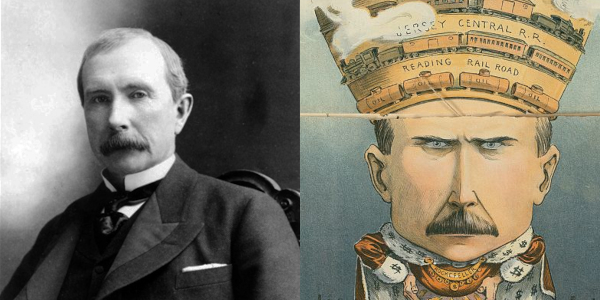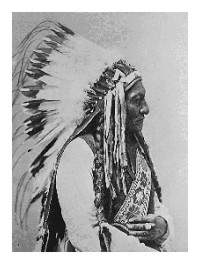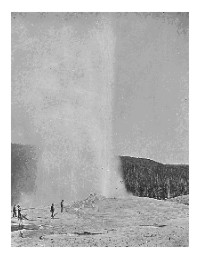Sponsor this page. Your banner or text ad can fill the space above.
Click here to Sponsor the page and how to reserve your ad.
-
Timeline
1870 - Detail
January 10, 1870 - Standard Oil Company is incorporated by John D. Rockefeller.

John D. Rockefeller had been in the oil refining business for the better part of the past decade, starting at twenty-three years of age with his first business partner, William B. Clark. What had started out as a produce commission business in 1858, selling $450,000 of product in their first year, now concentrated on oil, which, with government subsidizing its price during their first years in business, corresponded with the building of their first oil refinery in Cleveland in 1863. That refinery was owned by Andrews, Clark & Company, which included Rockefeller, and produced kerosene with sixty percent of the oil, the main product of the day, as well as finding other uses for the forty percent left over. Their main competitors were those from the Oil Creek area of northern Pennsylvania. Two years later, Rockefeller bought out the Clark Brothers for $72,500, establishing Andrews and Rockefeller. Samuel Andrews had been the original chemist in the initial company. But they had competitors. In Cleveland alone, with readily available rail lines, there were thirty refineries in total, with a capacity of two thousand barrels per day.
Through expansion of railroads, Rockefeller borrowed heavily to keep up with the burgeoning industry. Another partner, Henry Morrison Flagler, was brought into the business in 1867. Within one year, Andrews, Rockefeller, and Flagler were the largest oil refining business in the world with two refineries and a New York marketing subsidiary.
On January 10, 1870, John D. Rockefeller and Henry Morrison Flagler established the Standard Oil Company of Ohio, dissolving their old firm and capitalizing the new firm with one million dollars over ten thousand shares. John D. Rockefeller received 2,667 shares; silent partner Stephen P. Harkness 1,334; brother William Rockefeller 1,333, Henry Flagler 1,333, Samuel Andrews 1,333, Oliver Burr Jennings 1,000, and Rockefeller, Andrews and Flagler, the former firm, 1,000 shares. At this time, Standard Oil had a refining capacity of 1,500 barrels of oil per day.
Standard Oil quickly became the standard for all oil refiners, as well, through subsidiaries such as the South Improvement Company, began to dominate the shipment of oil through controlling freight rates. This cartel practice was eventually revoked by state authorities in Pennsylvania, raising the ire of the press and public against Rockefeller for the first time.
Standard Oil and Their Competitors
Despite the negative press and consternation about the cartel's practice, Rockefeller and Standard Oil were undeterred in their goal to dominate the industry. In 1872, Standard Oil acquired twenty-two of their twenty-six refining competitors in Cleveland. Rockefeller was an astute business man, often showing his competitors the profits on his books before making them an offer. If they refused, he would run them into bankruptcy then buy their assets at auction. He kept prices of his Standard Oil low to discourage competitors.
By the end of the 1870's, Standard Oil refined ninety percent of the oil in the nation and had invented additional products with an oil base such as paint and petroleum jelly.
Charges of running an oil monopoly began to take place just as Rockefeller began to disperse his transportation options, including use of the Erie Canal during summer months. When Rockefeller attempted to install pipelines to thwart the railroads, the Pennsylvania Railroad began to build refineries through a subsidiary to battle Standard Oil. Their effort did not work, eventually selling their oil based subsidiary back to Standard Oil and Rockefeller. In 1879, due to the monopolistic manner in which Rockefeller was conducting his business, particularly in the battle with the Pennsylvania Railroad, the Commonwealth of Pennsylvania indicted Rockefeller for his monopoly. This, and lawsuits in other jurisdictions, pushed negative press throughout the nation against Standard Oil.
Standard Oil stood firm in their horizontal and vertical platforms, often responding to negative press with the fact that since they had been in business, the public had benefited from an eighty percent decrease in kerosene prices.

Photo above: Montage (background) Stock share of the Standard Oil Company, 1878. Courtesy Wikipedia Commons; (inset) John D. Rockefeller, 1875. Courtesy Wikipedia Commons. Photo below: Montage (left) John D. Rockefeller, 1885, the Rockefeller Archive Center. Courtesy Wikipedia Commons; (right) Cartoon cover of John D. Rockefeller, 1901, John S. Pughe, Puck Magazine. Courtesy Library of Congress. Info Source: "The History of Standard Oil Company," 1904, Ida M. Tarbell; Library of Congress; Wikipedia Commons.




